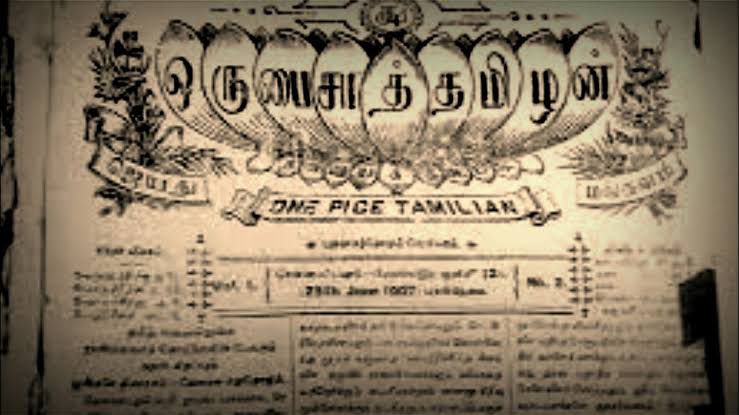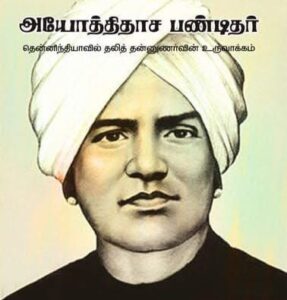Thass was India’s first modern Buddhist revivalist, and one of its earliest anti-caste intellectuals. His efforts to reimagine Tamil identity, demand caste annihilation, and resurrect Buddhist history laid the foundation for future icons like BR Ambedkar.
Published Jun 19, 2025 | 3:29 PM ⚊ Updated Jun 23, 2025 | 8:48 AM

'Oru Paisa Tamilan' published by Iyothee Thass Pandithar. (Supplied)
Synopsis: Iyothee Thass Pandithar defied not just Brahminical hegemony but also colonial erasure. In rejecting the caste identity imposed by the Hindu framework and the ethnic categories imposed by the British, he pioneered a postcolonial consciousness years before the end of colonial rule.
In the early 20th century, from the glinting mines of Kolar, Dalits unearthed wealth they would never own.
Yet, amid this injustice, they invested in something priceless. They gifted a printing press to a man, Iyothee Thass Pandithar, society tried to silence.
From that press emerged Oru Paisa Tamilan (One Pice Tamilian) in 1907, a Tamil weekly that cost a single paisa but carried messages that were beyond price. It came not from arms, but from ink.
Born as Kathavarayan in 1845 in the heart of Madras, Thass trained in Tamil Siddha medicine, embodying indigenous knowledge systems. But healing individual bodies wasn’t enough. He turned to social healing. Influenced by his Tamil teacher Vallakalathi Ayothidasa, he transformed himself into Iyothee Thass Pandithar, welding ideas as his medicine and language as his remedy for caste-based wounds.
In the 1870s, Thass began mobilising indigenous tribal communities in the Nilgiris, recognising caste as a colonising force. He established the Advaitananda Sabha in 1876, one of India’s earliest anti-caste movements. In 1885, he teamed up with reformer John Rathinam to launch the journal Pandian, and in 1886, declared unequivocally that “untouchables are not Hindus.”

Iyothee Thass Pandithar (20 May 1845 – 5 May 1914). (Supplied)
This rejection of caste Hinduism wasn’t just spiritual, it was revolutionary.
When the colonial state’s 1891 census tried to fit oppressed castes into the Hindu order, Thass resisted. Alongside Rettamalai Srinivasan, he co-founded the Panchamar Mahajana Sabha, representing communities outside the varnashrama system. He submitted a memorandum to the British, demanding recognition of Dalits as Adhi Tamilar, the “original Tamils.”
He urged them to register as “Casteless Dravidians” in the census, challenging not only caste but also the colonial framework that upheld it.
Thass wasn’t merely denouncing Hinduism; he was resurrecting buried heritage. He argued that Dalits were descendants of Tamil Buddhists whose lands, temples, and autonomy had been obliterated by Aryan conquest and Brahminical dominance. In 1900, he formally embraced Buddhism at Maligakanda Vihara in Ceylon (now Sri Lanka), with the help of Colonel HS Olcott, a key figure in global Buddhist revival. In 1902, he founded the South Indian Buddhist Satyavadi Sangham in Chennai.
It was in this radical moment that Oru Paisa Tamilan was born. Its name mocked society’s dismissal of Dalits as worthless.
“They say a Dalit isn’t worth a paisa,” Thass wrote, “but let them read this paper—they’ll find him priceless.”
Later known simply as Tamilan, the weekly bore the lotus symbol of Buddhist enlightenment. Thass filled its pages with serialised works like Buddhar Aadhi Vedam, Thiruvalluvar Charithiram, and Indira Desa Charithiram, blending Tamil identity with Buddhist thought, and using print as a battlefield against caste.
Thass’s writings weren’t abstract. He called for land redistribution, temple entry, public employment, and separate schools for Dalits.
At the 1891 Nilgiris provincial conference, he laid out 10 visionary resolutions, which directly informed the Panchami Land Scheme of 1893—a policy that allocated land to Dalit communities. Long before the vocabulary of “affirmative action” existed, Thass had already mapped the principles of social justice and dignified representation.
Thass defied not just Brahminical hegemony but also colonial erasure. In rejecting the caste identity imposed by the Hindu framework and the ethnic categories imposed by the British, he pioneered a postcolonial consciousness years before the end of colonial rule. His insistence that Dalits were Buddhists and original Tamils, not degraded Hindus, radically recentered Indian history through Dravidian eyes.
Hindu orthodoxy portrayed Dalits as “fallen” people—those who had deviated from Dharma and thus suffered karmic consequences. Thass tore through that spiritual fiction. He refused to let the label “Hindu” define the oppressed and instead declared that Dalits were never Hindu to begin with. They were the Adhi Tamilar, he argued—rooted in a history long predating the Aryan incursion and the varnashrama system.
By doing so, he refused to engage in mere reform of caste. He sought instead its complete annihilation—not by absorption, but by radical disengagement. This was not integration, but identity reclamation.
Thass fused Tamil identity, Buddhist legacy, and anti-caste radicalism into a singular vision. By tracing Dalit ancestry to Tamil Buddhists, he pulled their history out from under two dominant forces: the Sanskritised Hindu tradition and the British-imposed racial taxonomies. This was not a myth-making exercise, but a reclaiming of historical continuity.
To call his work “postcolonial” is to understand that Thass anticipated the politics of decolonisation decades before India’s independence. He showed that liberation from the empire must also involve liberation from social and cultural oppression rooted in caste. For him, Buddhism was not only an exit from Brahminism but also an alternative to imperial religion and hierarchy.
To be exact, Thass was India’s first modern Buddhist revivalist, and one of its earliest anti-caste intellectuals. His efforts to reimagine Tamil identity, demand caste annihilation, and resurrect Buddhist history laid the foundation for future icons like BR Ambedkar. In many ways, Thass turned the humble printing press into a weapon of intellectual insurgency.
This powerful dual rebellion against both caste and colonialism makes Thass not just a social reformer, but one of India’s most visionary anti-caste intellectuals, whose ideas still pulse through contemporary Dalit, Tamil, and Buddhist assertion movements.
Also, Thass didn’t wait for history to remember him—he wrote himself into it. At a time when both caste and colonialism worked to erase Dalit memory, he countered with tools sharper than violence: print, philosophy, and pride. He didn’t just oppose oppression; he exposed it for what it was—a distortion of who his people had been and could still become.
His Tamilan weekly wasn’t about news. It was about voice. About saying what others wouldn’t print, about remembering what temples wouldn’t inscribe. He reminded the forgotten people that they were once rulers, scholars, Buddhists—not outcasts, but origin.
Long before independence became a national slogan, Thass was calling for a different kind of freedom. Not just from foreign rulers, but from the hierarchies at home. His revolution didn’t need an army. It had ink. And a paisa.
Even today, whenever justice is demanded in Tamil Nadu or equality is envisioned across India, Iyothee Thass Pandithar is not a figure of the past—he is a voice still in progress, a struggle yet to be completed.
(Edited by Majnu Babu).
